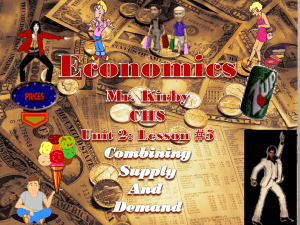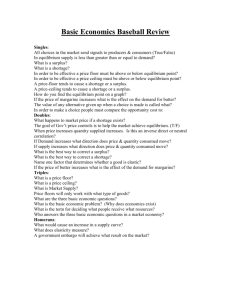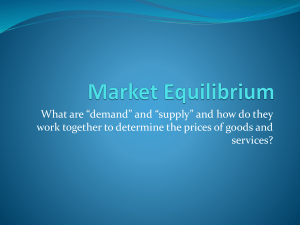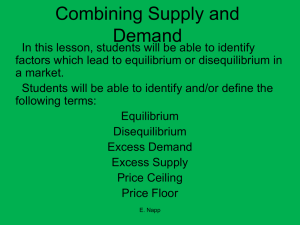Ch6Sec1
advertisement
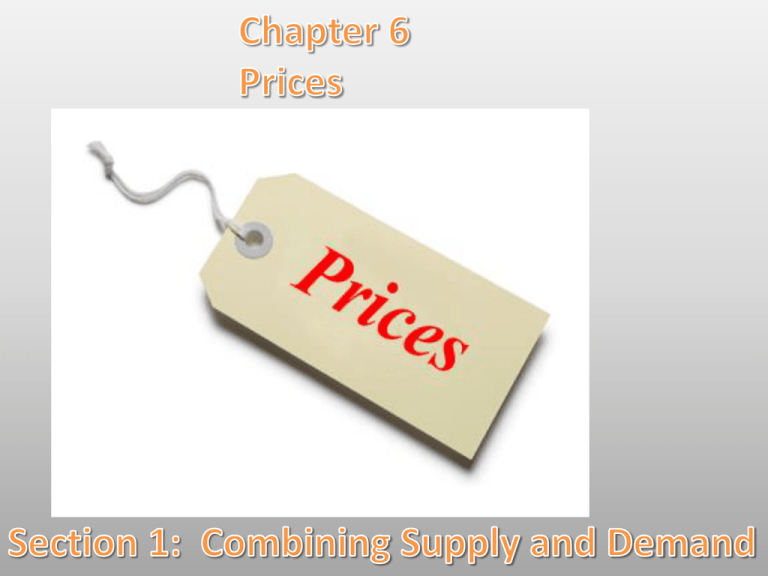
Lesson Objectives: By the end of this lesson you will be able to: *Explain how supply and demand create equilibrium in the marketplace. *Identify two ways that the government intervenes in market to control prices. *Analyze the impact of price ceilings and price floors on a free market. Reaching Equilibrium The easiest way to understand the relationship between supply and demand is the take a look at a supply and demand schedule. Supply Schedule: compares how much of a good a firm is willing to sell at various prices. Demand Schedule: Compares how much of a good a consumer is willing to buy at various prices. Combined Supply & Demand Schedule The chart below shows that equilibrium is reached when the price of a slice of pizza causes the quantity demanded by consumers to be the same as the quantity supplied by the restaurant owner. Price of a slice of Pizza Quantity Demanded Quantity Supplied Result $1.00 300 100 Shortage From Excess demand $2.00 250 150 Shortage from Excess demand $3.00 200 200 Equilibrium $4.00 150 250 Surplus from excess demand $5.00 100 300 Surplus from excess demand $6.00 50 350 Surplus from excess demand Supply and Demand Meet The point where demand and supply come together is called the equilibrium. Equilibrium is the point of balance at which the quantity demanded equals the quantity supplied. At equilibrium, the market for a good is stable. Market Benefits In any market, supply and demand will be equal at only one price and one quantity. At this equilibrium price, buyers will purchase exactly as much of a good as firms are willing to sell. When a market is at equilibrium, both buyers and sellers benefit. Disequilibrium If the market price or quantity supplied is anywhere but at the equilibrium, the market is in a state of disequilibrium. Disequilibrium occurs when quantity supplied is not equal to quantity demanded in a market. Disequilibrium can produce one of two outcomes: shortage or surplus. Shortage Shortage exists when the quantity demanded in a market is more than the quantity supplied. This happens when the price of the item is below the equilibrium price. The low price encourages buyers and discourages sellers. Surplus A surplus exists when quantity supplied exceeds quantity demanded and the actual price of a good is higher than the equilibrium price. The higher price encourages the firms to produce more of the good, but it discourages customers from buying the good. Price Ceiling Sometimes the government intervenes to control prices. The government can impose a price ceiling or a maximum price that can be legally charged for a good or service. The price ceiling is set below the equilibrium price. An example of a price ceiling is rent control which is a price ceiling placed on apartment rent. Price Floors A price floor is a minimum price, set by the government, that must be paid for a good or service. Governments set price floors to ensure that certain sellers receive at least a minimum reward for their efforts. Sellers can include workers, who sell their labor. An example of a price floor is the minimum wage, which sets a minimum price that an employers can pay a worker for one hour of labor.





